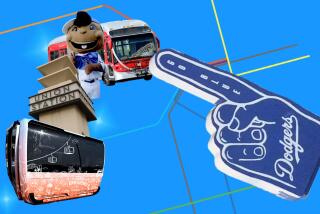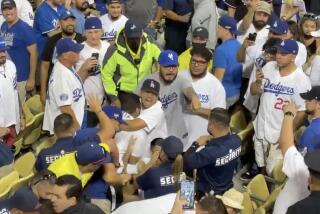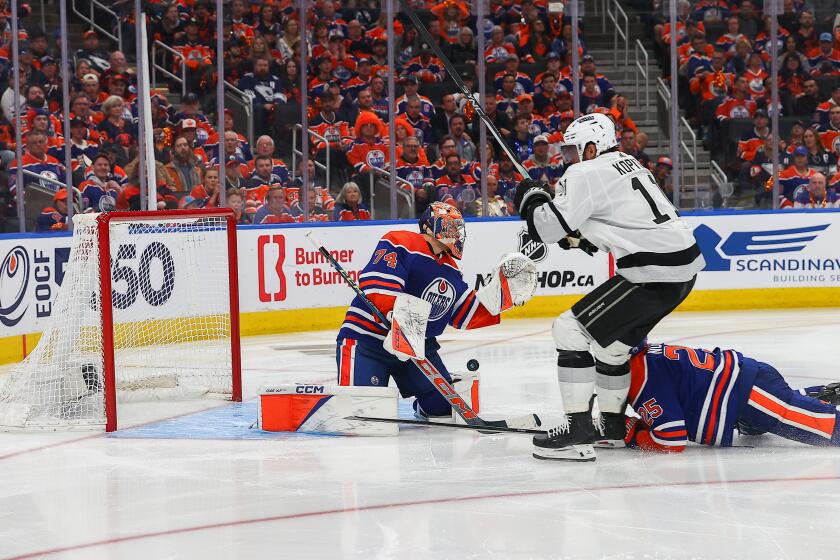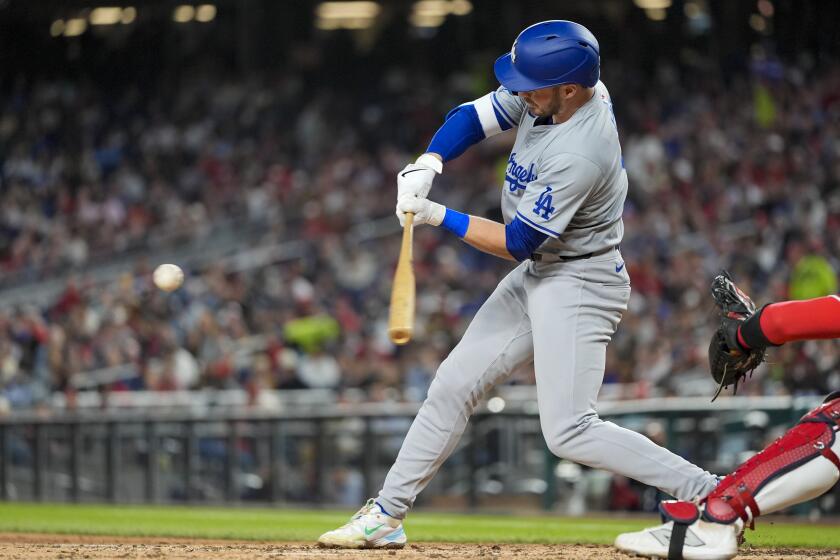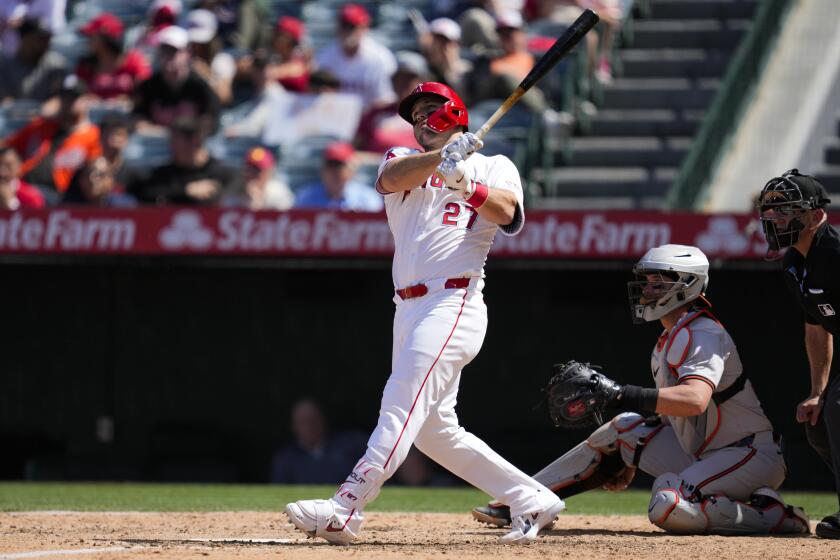For Vin Scully, the view from Dodger Stadium never gets old
When Vin Scully arrived from Brooklyn with the Dodgers for the 1958 season, he found Los Angeles to be lacking a core.
“What was it that Gertrude Stein said about Oakland? She said, ‘There is no there there.’ ” Scully said. “When I came to Los Angeles, all I knew was that it was like 450 square miles. There was no ‘there.’ I felt Los Angeles did not have a centerpiece.”
The opening of Dodger Stadium in 1962 changed that.
“In a sense, Dodger Stadium put the ‘there’ in Los Angeles,” Scully said. “I believe the stadium helped to reunite this spacious community that extends from here to there.”
The stadium opened exactly 50 years ago Tuesday, and the Hall of Fame broadcaster shared his thoughts and memories of the ballpark in a recent interview:
Opening Day, 1962:
“I certainly remember losing. I can still see [Cincinnati’s] Wally Post hitting a home run right between the two poles in dead center, like a field goal. … I don’t know why, but it sticks in your mind. I can see Wally Post, boom!
“Johnny Podres, who had been our World Series hero, he lost. So it began with a little bit of a heartbreak and it ended that year in that playoff game with the Giants. So it was quite a year — pain at both ends, excitement in the middle.” [The Dodgers and Giants tied for first place in the National League, but San Francisco won a tiebreaker series, two games to one.]
Comparing Dodger Stadium and the Coliseum, where the Dodgers played from 1958-61:
“The Coliseum was awkward. … They had to put a screen up in left field. So it was a funny feeling to be watching a baseball game in a football stadium that was built for track.
“And then to move to this beautiful, magnificent baseball stadium. It wasn’t multi-purpose, it was just for baseball. I think the baseball fan really appreciated that.”
Fans taking their transistor radios to the game to listen to his broadcasts:
“It was a major, major break for me, the invention of the transistor radio. ... The people knew the stars — they knew Willie Mays and Stan Musial — but they didn’t know the rank-and-file players. So this transistor radio was an aid.
“I had a fun night in Dodger Stadium. ... I guess they were playing Cincinnati. Maury Wills was stealing bases more than anybody had seen, and the pitchers were cheating. The rule specifically said you had to come set for one full second. The Dodgers were claiming [the] pitcher was balking, trying to cheat Wills.
“There was a huge rhubarb on the field. Now, I had time. So I said, ‘How long do you think one full second is?’ I said, ‘I’ll tell you what I’ll do. I’ll say the letter ‘A.’ I have a stopwatch in my hand. And when you say ‘B,’ that will be your guess as to when a second is.’ It was hysterical.
“I said, ‘A!’ and the crowd roared, ‘B!’ Now, I’ve got ‘em. I don’t want to let them go. So, when they said ‘B!’ I said, ‘Oh, come on. You’re kidding me. That’s not even close.’ I say, ‘Let’s try it again: A!’ My God, the heavens shook with this, ‘B!’ The phone rings in the booth. It’s the bench: ‘What in the hell is going on? Why is the crowd saying B?’ ”
The late owner Walter O’Malley’s hobby and its influence on the landscaping:
“Mr. O’Malley loved the soil. He was a great orchid grower. You could go to [the Dodgers’ spring-training home in] Vero Beach [Fla.] and there’d be some man on his hands and knees digging, working on the roots of a plant — khaki pants, khaki shirt, big hat, and it’d be Walter O’Malley. You’d think it was some groundskeeper.
“He was just loved the soil and to grow things. So it was his idea to make sure we had some color, some flowers.”
Construction insight from O’Malley:
“Mr. O’Malley pointed out an interesting thing that I never thought of. They were building the stadium and he said, ‘The most expensive seats are the cheapest to install. And the cheapest seats are the most expensive to install.’
“He said, ‘The box seat is the most expensive. It’s right on the ground. The cheapest seat is way the hell up there. Just think of all the steel and concrete and everything else you need to put that seat way up there.’ ”
The now-extinct dugout seats:
“We were in Japan in 1956 after the World Series and we played a lot of games in Tokyo. They had seats that were dugout seats. They were behind home. You were eye level with the field. Mr. O’Malley thought that would be kind of a nice thing for Dodger Stadium.
“Now, I was told this was absolutely true: Giants-Dodgers game, late in the game, Giants rallying, crowd going bananas, Willie Mays in the on-deck circle and all that stuff, Willie McCovey going to hit in back of him, and Milton Berle, a comedian, is sitting in a dugout seat.
“Now, Mays is going to come up. And as Mays started to walk up to the plate, Berle hollered, ‘Willie!’ Mays looked over and recognized Berle. Berle said, ‘Come here a minute.’ Willie actually started, instinctively, to come over and realized, ‘What am I, crazy? I’m in the middle of a game!’
“Doris Day used to love those seats. She was a sweet lady. You would see her a lot. Cary Grant, when he was married to Dyan Cannon, they would sit in those dugout seats.”
The view:
“I’ve said it so many times that it probably wears people out. But there are those summer evenings when you’re looking out and you remember the words, ‘purple mountains’ majesty.’ You see that and you think, ‘There isn’t anything like this in all of baseball.’ Oh, yeah, the sense of beauty is still there, for sure.”
On the prospect of Dodger Stadium being torn down and replaced:
“It would be [sad] for me, sure, because so many memories are in there. I don’t honestly believe that I will see it go in my lifetime, unless I live a particularly long time. But you don’t know. New ownership now. Who the heck knows?
“It needs, like all of us after a certain age, a touch-up. … It would be sad to tear it down. But they might build some unbelievable thing that makes you say, ‘Oh my gosh, this is the most ...’ So who knows? But as far as memories, oh yeah. For those of us that spend any time there at all, the memories.
“That’s the charm about baseball. People remember. They remember players. They remember moments. A lot of them happened in Dodger Stadium. It’s like an old family album, full of events and pictures. Sure, someday it can be changed. It would never be quite the same, though.”
More to Read
Get our high school sports newsletter
Prep Rally is devoted to the SoCal high school sports experience, bringing you scores, stories and a behind-the-scenes look at what makes prep sports so popular.
You may occasionally receive promotional content from the Los Angeles Times.

